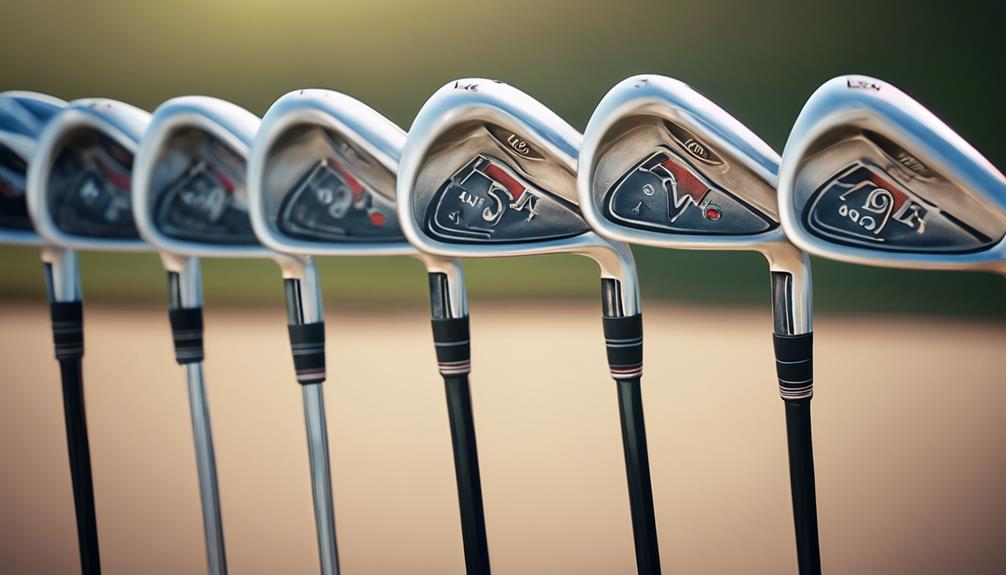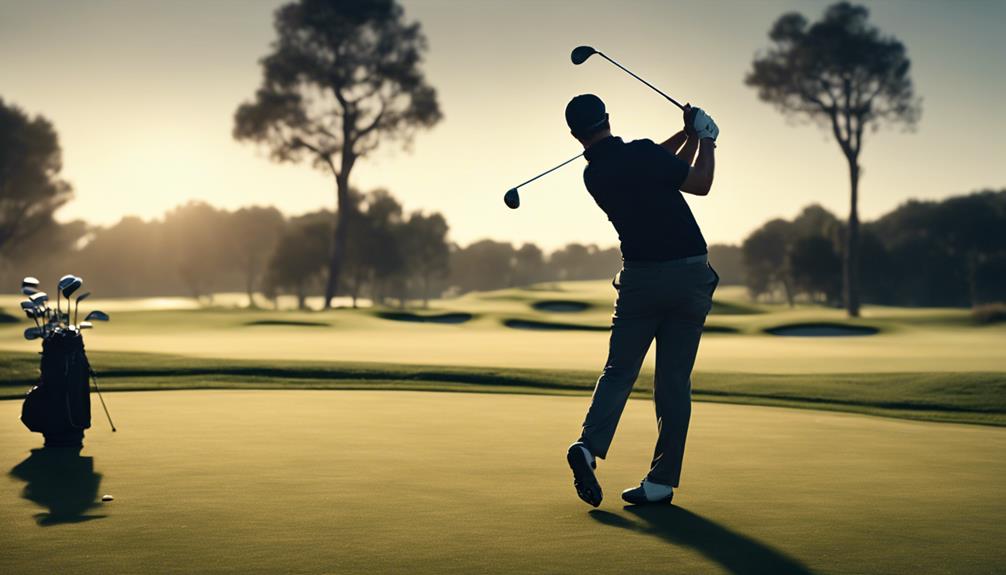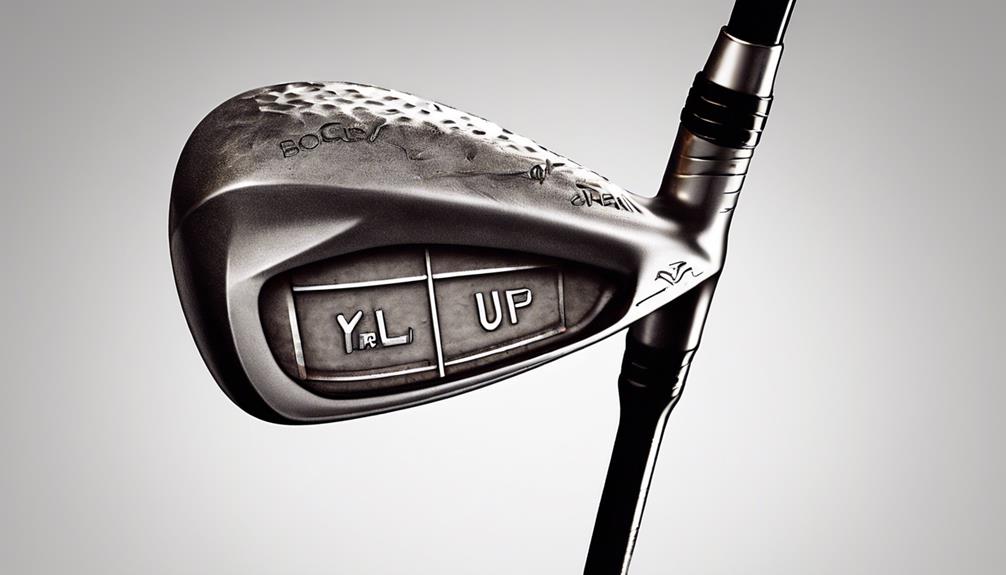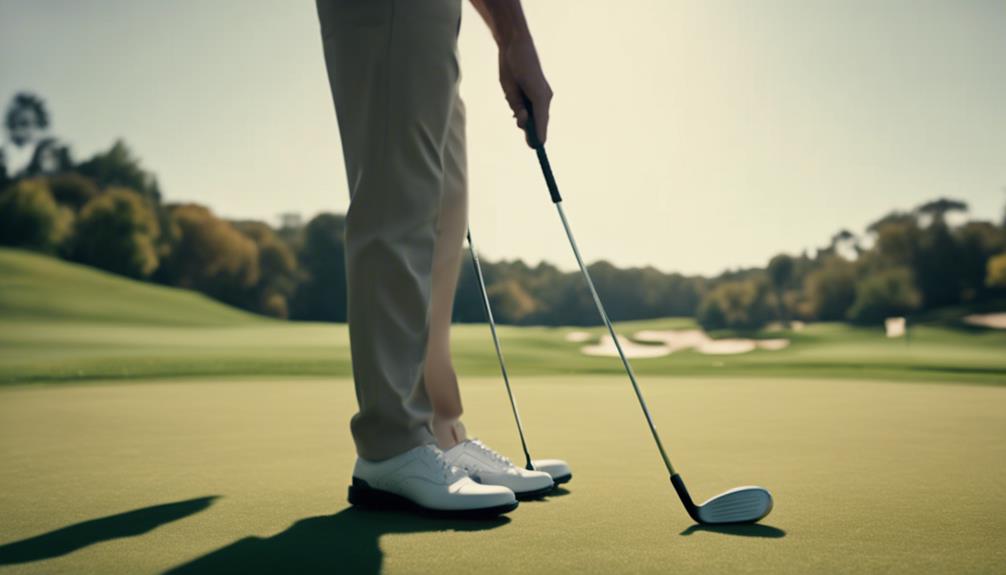- 7 Top Flite Golf Clubs XL for Improved Performance - September 28, 2024
- Top Flite Golf Clubs: Top 5 Reasons to Choose Them - September 28, 2024
- Top 3 Golf Club Fitters for a Perfect Swing - September 28, 2024
You hold a golf club in your hands, comprising a head, shaft, and grip, with each component carefully crafted to maximize physics within golf rules. The head's loft angle influences trajectory and distance, while the shaft's length and material affect the club's overall performance. Irons focus on precision and control, woods prioritize forgiveness and distance, and hybrids combine the two. Understanding these characteristics is key to selecting the right club for your shot. As you explore the nuances of golf clubs, you'll discover how to unleash your full potential on the course, and the secrets of the game will begin to reveal themselves.
Key Takeaways
- A golf club's head, shaft, and grip work together to produce a desired ball flight, trajectory, and distance.
- Loft angle, a key club characteristic, influences trajectory and distance, with lower lofts resulting in longer shots at lower heights.
- Club selection depends on various factors, including terrain, wind, and distance, and understanding club characteristics is crucial for informed decisions.
- The design and components of a club, such as clubhead material, grip, shaft, and head, contribute to its performance and feel.
- Proper swing mechanics, including grip, stance, alignment, and clubface angle at impact, are essential for consistent ball striking and maximizing performance.
Golf Club Basics and Manufacturers
What makes a golf club tick, and who are the key players behind its design and manufacturing? As you explore the world of golf, understanding the basics of golf clubs and their manufacturers is essential.
A golf club consists of three main components: the head, shaft, and grip, each playing a significant role in performance.
When it comes to club manufacturers, Pinemeadow Golf Products, Inc. is a reputable name in the industry, offering a wide range of clubs tailored to meet individual golfers' needs. With millions of satisfied customers, Pinemeadow Golf has established itself as a leader in club design and manufacturing.
Modern golf club sets typically include woods, hybrids, irons, and putters, catering to different types of shots in the game. Club manufacturers like Pinemeadow Golf aim to maximize physics within the constraints of golf rules to create clubs that enhance players' performance.
Types and Characteristics of Golf Clubs
As you explore the world of golf clubs, you'll encounter various types, each designed to excel in specific situations, with distinct characteristics that set them apart from one another. Understanding these differences is essential to selecting the right club for your shot.
| Club Type | Characteristics |
|---|---|
| Woods | Long-distance shots, low loft angle (7-12 degrees) |
| Hybrids | Combine fairway wood design with iron length, forgiving alternative to long irons |
| Irons | Shots under 200 yards, higher-numbered irons are easier to hit and more forgiving |
Hybrids offer a unique advantage, blending the best of both worlds to provide a more forgiving option for shots that require distance and accuracy. Meanwhile, irons are designed for shots that require precision and control, with varying loft angles to suit different situations. As you explore further into the world of golf clubs, you'll discover the nuances of each type, and how they can help you master the game. By understanding the characteristics of each club, you'll be better equipped to make informed decisions on the course and take your game to the next level.
Understanding Golf Club Numbers

As you explore the world of golf clubs, you'll notice that each club has a number, which directly correlates to the loft angle of the club face.
You'll need to understand how this loft angle affects the ball's trajectory and distance to make informed club selections.
Club Loft Angle
When selecting a golf club, you need to think about the loft angle, which is the angle of the club face that greatly influences the trajectory and distance of your shot. The loft angle determines how high and how far the ball will fly.
A lower loft angle results in a lower trajectory and longer distance, while a higher loft angle produces a higher trajectory but shorter distance.
As you analyze golf club numbers, you'll notice that lower numbers, such as a 3-iron, have less loft, resulting in longer shots at a lower height. In contrast, higher numbers, like a 9-iron, have more loft, producing a higher trajectory but shorter distance.
Understanding the loft angle is vital for selecting the right club for the desired shot outcome. By grasping this concept, you'll be able to choose the perfect club to achieve the trajectory and distance you need to excel in your game.
Golf Ball Trajectory
You can predict the path of your golf ball by understanding the connection between golf club numbers and loft angles, which directly impacts the ball's height and distance.
As you know, each golf club number corresponds to a specific loft angle, and this combination determines the ball's flight path. Lower golf club numbers, such as a 3-iron, have less loft, resulting in longer distances at a lower height. Conversely, higher golf club numbers, like a 9-iron, have more loft, producing a higher path but shorter distance.
Understanding this relationship is essential for choosing the right club for your desired shot outcome. By selecting a club with the appropriate loft angle, you can control the path of your ball, achieving the best height and distance for your shot.
For instance, if you need to clear a tree or navigate a dogleg, a higher-lofted club will provide the necessary elevation. On the other hand, if you're looking to drive the ball down the fairway, a lower-lofted club will give you the distance you need.
Difference Between Wood and Iron Clubs
As you learn to navigate the golf course, you'll need to understand the key differences between wood and iron clubs. One of the most critical distinctions lies in their club head design, which greatly impacts their performance and functionality.
You'll find that wood clubs feature larger, circular heads, while iron clubs boast smaller, angled heads, each suited to specific shot requirements.
Club Head Design
The distinct club head designs of wood and iron clubs, characterized by size and angle, fundamentally influence their performance and suitability for different shots on the golf course.
As you select a club, you'll notice that wood clubs have larger, circular club heads designed for long-distance shots. This design allows for increased forgiveness and distance due to the larger club head size.
In contrast, iron clubs have smaller, angled club heads that provide more control and accuracy for shorter shots. The material and design differences between wood and iron clubs impact their performance and suitability for different types of shots.
Understanding these differences is essential for selecting the right club for each shot. You'll find that wood clubs are ideal for driving and fairway shots, while iron clubs are better suited for approach shots and chipping.
Wood Vs Metal
Golfers seeking to optimize their club selection must recognize the fundamental differences between wood and iron clubs, especially regarding design, material, and performance. While both types of clubs have their unique characteristics, understanding their distinctions is essential for making informed decisions on the course.
Here are the key differences between wood and iron clubs:
- Wood clubs are designed for long shots over 175 yards, offering increased forgiveness and distance due to their larger heads and metal construction.
- Iron clubs are ideal for shots under 200 yards from the green, providing more precision and accuracy with their smaller, angled heads.
- Wood clubs prioritize forgiveness and distance, whereas iron clubs focus on accuracy and shot shaping abilities.
- Hybrids combine the benefits of both, offering a versatile option for golfers seeking a balance between forgiveness and precision.
Applying Golf Club Knowledge in Real-World Situations

You'll find that translating golf club knowledge into effective course strategy requires a deliberate blend of practice, experience, and savvy decision-making.
As you navigate the course, you'll need to take into account factors like terrain, wind, and distance to select the right club for the shot. For instance, when faced with a high shot over a tree, you'll want to opt for a club that can deliver the necessary height and distance. In this case, a club with a higher loft angle, such as a 7-iron, may be the best option.
Remember, every club has three key characteristics: loft, lie, and length, which affect its performance. Understanding these characteristics is essential for making informed decisions on the course.
Golf Club Selection and Usage
Selecting the right golf club for a shot requires a deep understanding of each club's purpose, whether it's the driver's raw power for tee shots or the hybrid's precision for long-distance approaches.
To make informed decisions, you need to know your average distance with each club. You can do this by hitting 50 balls with each club, eliminating the extremes, and calculating the middle remaining shots. This will give you a clear picture of your capabilities with each club.
Here's what you should keep in mind when selecting and using your golf clubs:
- Understanding the purpose of each club is essential for making the right selection
- Knowing your average yardage with each club helps you make informed decisions during a game
- Regular practice helps you improve your skills and get closer to your average yardages
- Expert insights from PGA Champions Tour players like Gary McCord and resources like Dummies can provide valuable guidance on golf club selection and usage
Club Markings and Design Explained

As you examine your golf club, you'll notice various markings and features that reveal its design and functionality.
You'll see loft angle markings, which indicate the club's face angle in degrees, affecting the ball's trajectory and distance.
Loft Angle Markings
When examining a golf club, the loft angle marking, typically denoted by a number followed by a degree symbol (e.g., 46°), reveals the face angle of the club, an essential factor in determining the ball's trajectory.
As you explore the club markings, you'll notice that the loft angle affects the ball's flight, with higher loft angles resulting in higher shots and lower loft angles producing lower shots.
Here are some key takeaways about loft angle markings:
- A higher loft angle means the clubface is more vertical, resulting in a higher shot
- A lower loft angle means the clubface is more horizontal, resulting in a lower shot
- Loft angle markings vary across clubs, with drivers typically having lower loft angles (around 9-10°) and wedges having higher loft angles (around 46-60°)
- Understanding loft angle markings is essential for selecting the right club for each shot, as it directly impacts the ball's trajectory and distance.
Clubhead Materials Used
You'll find that clubhead materials, such as titanium, stainless steel, and composite materials, play a significant role in shaping your golf game by influencing factors like forgiveness, distance, and feel. The choice of clubhead material affects how you perform on the course, and understanding the differences is essential for selecting the right club for your shot.
Titanium, for instance, is known for its high strength-to-weight ratio, making it ideal for drivers and fairway woods where distance is key. Stainless steel, on the other hand, provides a softer feel and more forgiveness, making it suitable for irons and wedges. Composite materials, which combine different substances, offer a balance between distance and feel.
When examining club markings, you'll notice identifiers like 'P' for pitching wedge, as well as material information. This information is crucial in making informed decisions about your club selection. By understanding the clubhead materials and markings, you'll be able to choose the right club for your desired shot outcome, taking your game to the next level.
Wedges Vs. Irons: Key Differences
Distinguish between wedges and irons by recognizing that wedges boast higher lofts, catering specifically to short-range shots that demand precision and control. As a golfer, you need to understand the distinct characteristics of each to enhance your gameplay.
Here are the key differences between wedges and irons:
- Wedges have higher lofts, making them ideal for short-range shots, chipping, and pitching.
- Irons cover a broader range of distances with lower lofts compared to wedges, making them suitable for approach shots and fairway play.
- Wedges offer better control and accuracy, making them essential for certain types of shots, such as getting out of sand traps or maneuvering tight spaces.
- Having both a pitching wedge (P) and a sand wedge in your golf bag can enhance your versatility on the course.
How to Choose the Right Golf Club

Choosing the appropriate golf club for a specific shot entails a profound comprehension of each club's purpose and capabilities, along with careful assessment of factors such as distance, terrain, and shot type.
You must know when to utilize a driver for optimal distance, a wedge for high-angle shots, or a putter for accuracy on the green.
To make well-informed club selection decisions, understanding your average distance with each club is crucial, which you can ascertain through practice and data analysis.
Consult with knowledgeable golf instructors like Gary McCord or reliable sources like Dummies for valuable club selection tips.
By considering the particular requirements of each shot, you can select the right golf club to execute it effectively.
Remember, club selection is a vital aspect of golf, and making the correct choice can greatly enhance your game.
Golf Club Components and Their Roles
When it comes to golf clubs, understanding the distinct roles of each component is crucial, as the head, shaft, and grip work together in harmony to deliver a precise and powerful swing. You need to know how each part contributes to the overall performance of the club.
- The grip provides control and comfort, allowing you to maintain a consistent swing.
- The shaft transmits energy from your swing to the club head, influencing the club's flexibility and accuracy.
- The head of the golf club, designed specifically for woods, irons, or putters, affects forgiveness and distance.
- The materials used for the shaft, such as steel or carbon-fiber composite, impact the club's performance and feel.
Clubs are designed to work in harmony, with each component playing an essential role in your overall game. By understanding the roles of each part, you'll be better equipped to choose the right club for your individual playing style and preferences. This knowledge will help you make informed decisions when selecting a club, ensuring you get the most out of your game.
Mastering Golf Club Selection Psychology

You must consider your personal preferences, swing style, and playing habits to master the art of golf club selection, as the right clubs can make all the difference in your game.
Having a well-rounded set of clubs can greatly improve your overall performance, and understanding your individual needs and preferences is vital when choosing clubs.
The pressure to perform is highest at the tee and green, where having the right clubs is essential. You may find yourself carrying multiple drivers and putters, but only one set of irons tailored to your specific needs.
By understanding your golf club selection psychology, you can make informed decisions that impact your performance and enjoyment of the game. It's not just about having the right clubs, but also about understanding why you need them.
Maximizing Performance With the Right Clubs
By understanding how each club is designed to tackle specific challenges, you can enhance your performance on the course and make data-driven decisions to improve your game. With the right clubs, you can strike the golf ball with precision and accuracy, achieving better results and lowering your scores.
Here are some key considerations to keep in mind:
- Club head design: Different golf club heads are engineered to produce distinct ball flights, spins, and distances. Understanding these variations allows you to select the best club for each shot.
- Distance and trajectory: Choose clubs that match the required distance and trajectory for each shot, taking into account factors like wind, slope, and obstacles.
- Lie and surface interaction: Consider the lie of the ball and the surface you're playing from, as this affects the club's performance and the resulting shot.
- Conditions and adaptability: Be prepared to adapt your club selection based on changing course conditions, such as wet or dry surfaces, and adjust your strategy accordingly.
Frequently Asked Questions
How to Know What Clubs to Use in Golf?
To master club selection, you'll need to understand your swing mechanics and calculate your average yardage with each club, factoring in your skill level and technique, to guarantee you're choosing the right club for every shot.
What Do the Numbers Mean on Golf Club?
When you glance at your golf clubs, you notice numbers etched onto them; these digits represent the loft angle, which affects trajectory and distance, with lower numbers indicating longer clubs with less loft for farther shots.
What Does the P Stand for on Golf Clubs?
When you customize your club, you might wonder what the "P" stands for – it's not about grip size or shaft flex, but rather the Pitching Wedge, a versatile club that balances distance and precision in your approach shots.
When to Use a 5 Iron?
When you're facing fairway shots or approach shots requiring long distances with precision, you'll likely reach for your 5 iron, as it provides the necessary loft and accuracy to get you out of tricky situations.
Conclusion
As you stand on the green, your club selection is like traversing a treacherous maze – one misstep, and your game is lost. But with the right club in hand, you're a master explorer, charting a course to victory.
Remember, each club is a key that opens a specific shot, and mastering their unique characteristics is the secret to revealing your full potential. With this knowledge, you'll be the conductor of your own golf symphony, expertly orchestrating each shot to create a masterpiece of precision and skill.




